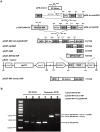Generation of marker-free transgenic plants concurrently resistant to a DNA geminivirus and a RNA tospovirus
- PMID: 25030413
- PMCID: PMC4101524
- DOI: 10.1038/srep05717
Generation of marker-free transgenic plants concurrently resistant to a DNA geminivirus and a RNA tospovirus
Abstract
Global threats of ssDNA geminivirus and ss(-)RNA tospovirus on crops necessitate the development of transgenic resistance. Here, we constructed a two-T DNA vector carrying a hairpin of the intergenic region (IGR) of Ageratum yellow vein virus (AYVV), residing in an intron inserted in an untranslatable nucleocapsid protein (NP) fragment of Melon yellow spot virus (MYSV). Transgenic tobacco lines highly resistant to AYVV and MYSV were generated. Accumulation of 24-nt siRNA, higher methylation levels on the IGR promoters of the transgene, and suppression of IGR promoter activity of invading AYVV indicate that AYVV resistance is mediated by transcriptional gene silencing. Lack of NP transcript and accumulation of corresponding siRNAs indicate that MYSV resistance is mediated through post-transcriptional gene silencing. Marker-free progenies with concurrent resistance to both AYVV and MYSV, stably inherited as dominant nuclear traits, were obtained. Hence, we provide a novel way for concurrent control of noxious DNA and RNA viruses with less biosafety concerns.
Figures



References
-
- Vanderschuren H., Stupak M., Futterer J., Gruissem W. & Zhang P. Engineering resistance to geminiviruses - review and perspectives. Plant Biotechnol J 5, 207–220 (2007). - PubMed
-
- Prins M. & Goldbach R. The emerging problem of tospovirus infection and nonconventional methods of control. Trends Microbiol 6, 31–35 (1998). - PubMed
-
- Pappu H. R., Jones R. A. & Jain R. K. Global status of tospovirus epidemics in diverse cropping systems: successes achieved and challenges ahead. Virus Res 141, 219–236 (2009). - PubMed
-
- Hanley-Bowdoin L., Bejarano E. R., Robertson D. & Mansoor S. Geminiviruses: masters at redirecting and reprogramming plant processes. Nat Rev Microbiol 11, 777–788 (2013). - PubMed
-
- Raja P., Wolf J. N. & Bisaro D. M. RNA silencing directed against geminiviruses: post-transcriptional and epigenetic components. Biochim Biophys Acta 1799, 337–351 (2010). - PubMed
Publication types
MeSH terms
Substances
LinkOut - more resources
Full Text Sources
Other Literature Sources
Research Materials
Miscellaneous

